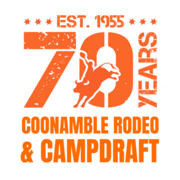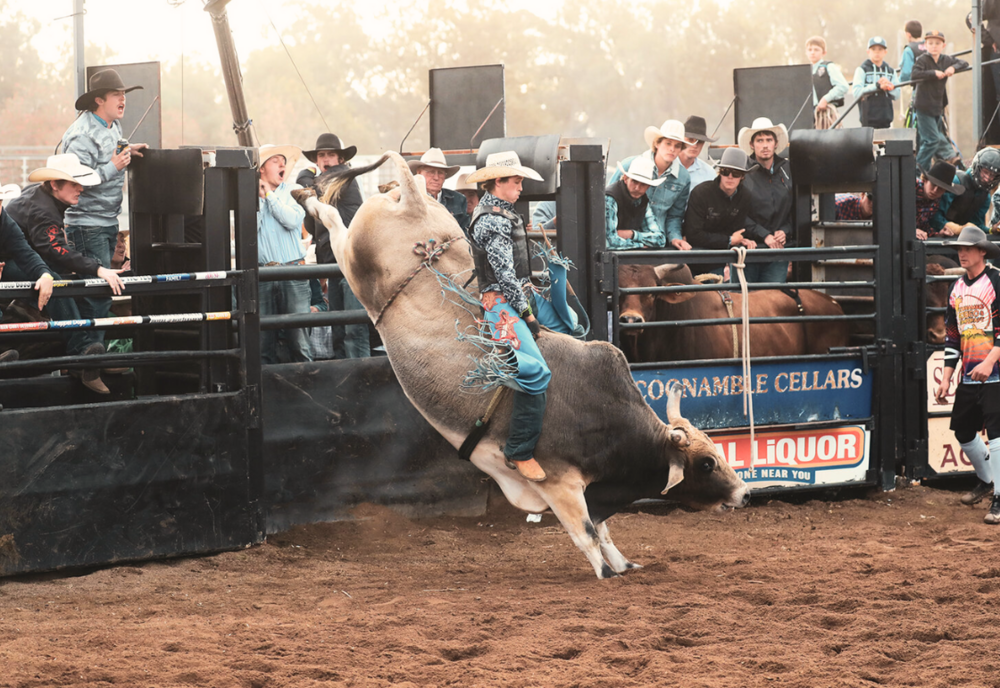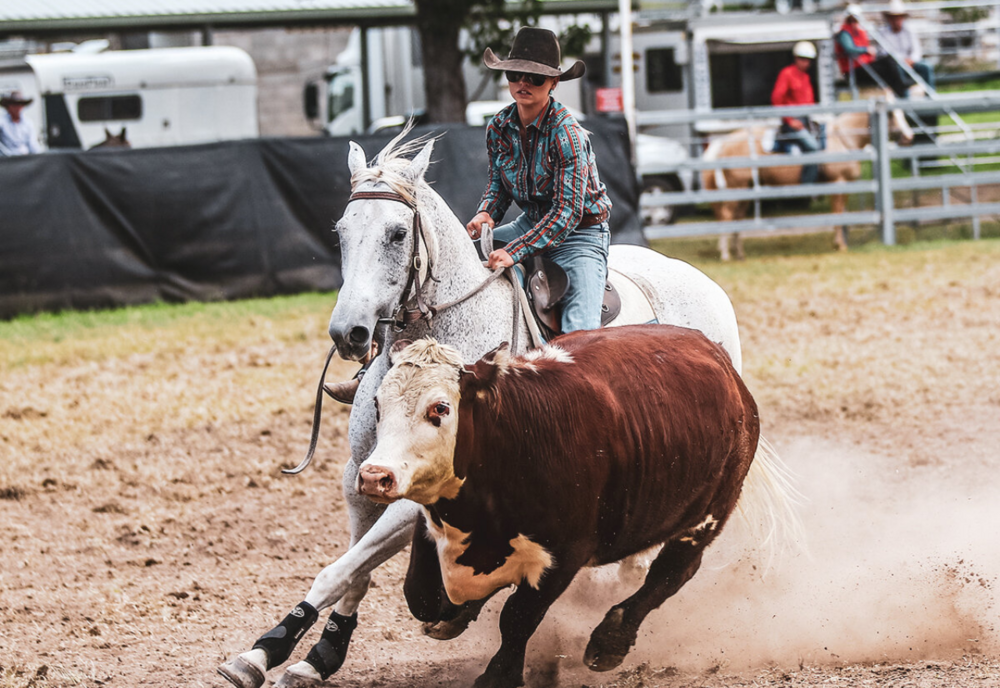
70 Years of Coonamble Rodeo & Campdraft
Running since 1955, the Coonamble Rodeo & Campdraft is the largest event held each year in the town and is the largest combined Rodeo/Campdraft in the Southern Hemisphere.
Around 1000 cowboys and cowgirls, along with approximately 4000 spectators, head across the central-western plains of NSW to the edge of the Outback, transforming the Coonamble Showground into a full-on explosion of wild riding action.
On Saturday & Sunday, the cowboy’s launch from the chutes competing for over $30,000 worth of prize money in steer wrestling, calf roping, barrel racing and, of course, the glamour events of the Saddle Bronc, Bareback and Bull rides. On Monday the Junior Rodeo sees the up and coming stars of the Rodeo circuit compete.
The Campdraft commences at daylight on Friday with an eight-event program and finals running through to Monday afternoon, with over $25,000 in prize money up for grabs. Competitors and campdraft enthusiasts come from as far as Queensland and Victoria.
The Coonamble Rodeo and Campdraft event is run by the Coonamble Rodeo Association, an unpaid volunteer committee.
History of Coonamble Rodeo
The first Rodeo ever recorded in Coonamble was run in conjunction with the annual P & A Show in 1934. It consisted of one event – a steer ride, won by Mr Doug Fisher. One-off events such as these were held each year with all proceeds going to charity. In 1946 the Coonamble Rodeo Association was formed and Rodeo’s were held in the middle of a hard dirt paddock where stock often got away and was “lost” for days!
In 1955 timber yards were built and the first official rodeo to be held in them was on November 12 1955. In 1958 the Rodeo Association was registered as a charitable organisation and all proceeds from the event in the past have been distributed to worthwhile organisations and causes in the community.
In 1964 the timber yards were replaced and upgraded by the Coonamble Shire Council. The giant sign that still stands today was built in 1984 and features paintings of Peter Burtenshaw, Johnny Lundholm and Glenn Peacock. The current steelyards were built in 1985 for the Australian Rodeo Championships, which were a resounding success.
The first Australian National Championships were held in Coonamble in 1971 and were sponsored by Amoco. Carlton United Breweries became a major sponsor in the ’80s with local business continually supporting the event throughout the years.
Today the Coonamble Rodeo & Campdraft attracts crowds of up to 6000, with the event injecting approximately $1.4million into the local economy.
Future plans include covering the existing arena to allow all-weather usage and prevent poor attendances due to bad weather. In 2010 the Association agreed to relocate the campdrafting arena and yards to the Southern end of the showground precinct which will improve access and overcrowding at the Northern end of the ground.

What is Rodeo?
Rodeo is made up of a wide range of events that test competitors in every way. These include:
Bull Riding
The most popular rodeo riding event and the most dangerous. A loose rope straps a man’s hand to a tonne of explosive power. Because the cowboy never knows what the animal beneath him is going to do next, he must draw upon his sharpest mental and physical abilities when trying to conquer this twisting tornado. To keep his position and balance, a bull rider is constantly grabbing for new holds with his feet and continually pulling up on the rope. The more powerfully a bull bucks and the faster he spins the more points the ride is worth.
Bareback Riding
A very demanding event for the competitor. From the moment the gate swings open and the horse and rider explode from the chute, both must perform exceptionally well if the cowboy is to win. A suit-case like handle is attached to the top of the leather rigging, cinched around the horse’s middle. The contestant grips this handle with one hand, keeps his other free and high in the air. Ideally bareback riders want to try to spur the horse on each jump, reaching as far forward as they can with their feet, then jerking their spurs upwards towards the rigging.
Saddlebronc
Considered the classic rodeo event, this competition is definitely not for beginners. There is a reason – the instinctive reactions required to keep in the stirrups, sense what the horse will do next and the ability to synchronise with the bronc’s movement- make this event one with no substitute for years of experience. Since there in nothing solid to hold on to, a cowboy can only stay in the saddle through timing and balance. The proven rider deliberately matches his spurring strides with the bucking bronc’s rhythm beneath him making the whole ride appear smooth.
Steerwrestling
An event that not only requires speed and agility, but also physical size and strength. When a man drops from the side of a galloping horse onto a running steer and throws him to the ground, spectators have seen athletic skill overcome heavily weighted odds. In keeping with the sharing and helping character of rodeo, the steer wrestler is allowed a partner called a ‘hazer’ to aid him in lining up the charging steer. This assistance helps to assure perfect placement of the steer and horse before the cowboy dismounts. The time stops after the contestant has thrown and turned the steer’s head and all four feet are out in the same direction.
Rope & Tie
An event that shows the grace and beauty of true horsemanship along with the athletic skills of both horse and rider. Roping is a race against time with the seconds counted in decimal points. To win, a horse and rider must work together in precision teamwork. The contest begins when the calf is released from the chute with the rider and horse chasing behind. A good horse will carry its rider in perfect accord with every move of the calf and when the rope is thrown will stop on a dime, back up so the rope is pulled taut allowing the roper to dismount, run down the rope, throw the calf and tie any three legs with the ‘piggin string’ and then signal ‘all clear’ with his hands in the air. The rider must remount his horse and slacken the rope to prove the tie, which must then hold for six seconds.
Team Roping
An event that owes its very existence to the everyday work of the American working cowboy. On the open range, it is often necessary to catch an animal in order to attend to or brand it, and that is where the first team roping took place. In rodeo competition today the header starts the time when he leaves the box in pursuit of the runaway steer. His job is to rope the steer’s horns, take a dally wrapping the loose end of the rope around the saddle horn and turn the steer away from his partner. With great skill and accurate timing the heeler then ropes the steer’s hind legs and takes his dally. Then both header and heeler face their horses towards the steer, time stops. Because of the excellent teamwork involved this event is a favourite of many.
Ladies Barrel Race
The all-female event that tests the speed and agility of both cowgirl and horse. The horses ridden in the event are highly trained and extremely athletic, matching their speed and turns to the cues given by the riders. The clock is set in motion when the girl and the horse cross the starting line and is stopped when she recrosses the line after completing her run. The colourful rider and her mount must make two turns in one direction and one in the other around the three barrels. These barrels are set in a triangular pattern, a prescribed distance apart. Winners are on many occasions determined by differences of hundredths of a second. So the five-second penalty for an overturned barrel can be devastating. This event is certainly one of sheer elegance and precise timing.
Breakaway Roping
Another all-female event which is the female version of calf roping. This event differs from roping in that the cowgirl does not have to rope the calf, dismount the horse and tie the calf’s legs. Instead, the rope is tied to the saddle horn with a ribbon. When the calf is roped, the horse pulls up and calf keeps running until the rope is taut, which then ‘breaks’ the rope from the saddle horn and the time is taken. This event is contested as hotly by these cowgirls as by the men in the roping.
Steer Undecorating
Another all-female event which is the female version of steer wrestling. However, in this event rather than having to slide over the side of the galloping horse and stop the steer, the cowgirl has to catch up to the steer and remove the ribbon attached to its back. Like the steer wrestling, the cowgirl is allowed a ‘hazer’ to aid her in lining up the charging steer. This helps her to line up the steer perfectly to allow her to remove the ribbon. Time is taken when she removes the ribbon from the steer and raises it high over her head.
(SOURCE: Australian Bushmen’s Campdraft & Rodeo Association 2014)

What is Campdraft?
Campdrafting involves a mounted rider riding into a “camp” or yard, which has six to eight head of cattle in it. The rider (cuts out) one steer or heifer from the cattle in the camp and brings that beast to the front of the camp and block and turns that beast at least two or three times to prove to the judge that they have the beast under control. The rider then calls for the gates to be opened. The cut out is worth a total of 26 points.
The rider then proceeds to draft (work) the beast around a figure of eight course in a larger arena.
Generally, the course is set to the left and once the beast has gone around the left peg, it must then be drafted around a peg on the right.
Once that is completed, the rider then guides the steer through the “gate” which is two pegs placed apart. Once gated, the campdraft run is complete and the rider can be awarded up to a total of 100 points. Points are awarded for horsemanship and control of the beast, within set time limits, usually 40 seconds.
(SOURCE: Australian Bushmen’s Campdraft & Rodeo Association 2014)